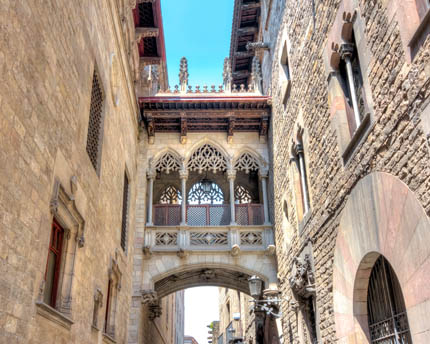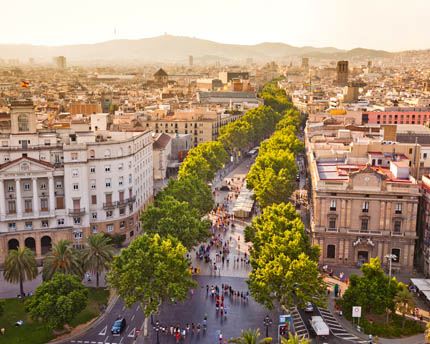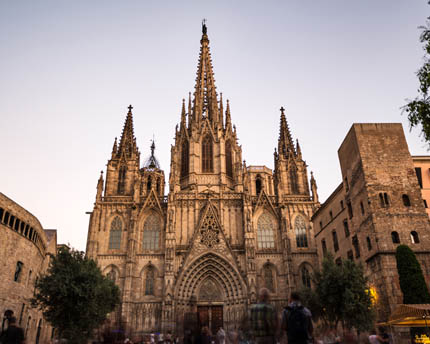Ciutat Vella
Few people realise that two streams once flowed under what are now the two most famous parallel streets in Barcelona, La Rambla and Via Laietana, and that in-between them stood a small hill: Mount Taber. It was right there where the Romans, between the years 15 and 10 B.C., founded the colony of Barcino, not knowing that the settlement would become one of Europe’s greatest cities. This is just one of the many interesting facts about Ciutat Vella, the first district and cradle of Barcelona, which was surrounded by a wall until it was demolished in 1854 so that the urban area could expand. Comprised of four large neighbourhoods—the Gothic Quarter, El Raval, Sant Pere, Santa Caterina i La Ribera, and La Barceloneta—the narrow streets and squares of the Ciutat Vella district boast 2,000 years of history, including Roman ruins, remains of medieval walls, Gothic and Baroque temples, and memories of its seafaring past, before taking us to the multicultural and tourism-oriented Barcelona of the present day.
The fragments of wall that have been preserved in the Gothic Quarter allow you to trace the perimeter of the ancient Roman Barcino, whose forum was on the site of what is now Plaça de Sant Jaume, where the Gothic palaces of the City Council and the Catalan Government face one another. Other vestiges from the Roman era are found in the inner courtyard of the Hiking Association of Catalonia, where four columns remain from the ancient Temple of Augusto, which once stood on the summit of Mount Taber, and under Plaça del Rei, which is now home to the Barcelona City History Museum.
If we journey back to medieval times, one of the greatest attractions of the Gothic Quarter are the narrow, meandering streets of the former Jewish quarter. Right in the heart of them is the refurbished Ancient Synagogue, one of the oldest in Europe, and, of course, Barcelona Cathedral, also known as Santa Creu i Santa Eulàlia Cathedral, and the Gothic churches of Santa Maria del Pi and Sant Just i Pastor. The neighbourhood also boasts magnificent squares such as that of Sant Felip Neri, with its beautiful Baroque church; Plaça Reial, a colonial delight with its palm trees and central fountain; and Plaça dels Traginers, which lies in the shadow of a tower that formed part of the old Roman wall. It’s almost mandatory to walk beneath the famous Pont del Bisbe bridge, which, although it may seem very old, is actually Neo-Gothic—like other historical constructions in the neighbourhood—and was built in 1928.
Towards the east, crossing Via Laietana, are the neighbourhoods of El Born and La Ribera, whose medieval origins contrast with their present-day artistic, modern and cosmopolitan feel, which has led the area to be described as Barcelona’s Montmartre. Its main historical treasures are the ancient Llotja de Mar, a former commercial exchange for the city’s tradesmen, and the Gothic basilica of Santa Maria del Mar, built in the fourteenth century by guilds of traders, artisans and fishermen from the neighbourhood, as those who have read Cathedral of the Sea, the famous best-seller by Ildefonso Falcones, will know. On Carrer Montcada, replete with old stately palaces and medieval courtyards now converted into art galleries, a must-visit is the Picasso Museum, which houses paintings from the youth of the Malaga-born painter.
Heading west, after crossing Les Rambles and stopping to admire the prestigious Liceu opera house, is the neighbourhood of El Raval—an area that once lay outside of the medieval city walls—which has taken on an authentic character, typical of a traditionally proletarian neighbourhood with a large immigrant community. Wandering through the jumbled streets of what was not long ago known as the barrio chino—or the red-light district—of Barcelona you’ll stumble across modern spaces such as the Museu d’Art Contemporani (MACBA), the Centre de Cultura Contemporània (CCCB) and the Filmoteca de Catalunya film archive, which have given the area an air of culture. There are also magnificent Gothic buildings such as the Royal Shipyard dating from the thirteenth century, where galleys were built, and the former Hospital de la Santa Creu from the fifteenth century, now the National Library of Catalonia. The Romanesque monastery of Sant Pau del Camp, the oldest building in El Raval—and almost in Barcelona—transports us all the way back to the tenth century.
The seafaring spirit of the old town lies in La Barceloneta, a coastal neighbourhood built upon sandy land in the eighteenth century to rehouse the city’s inhabitants affected by the construction of the military fortress of La Ciutadella, which is no longer in existence. The area’s most iconic places include the hundred-year-old Barceloneta Market, famous for selling the freshest fish, and Barceloneta Beach, where, in addition to taking a dip, you can catch the cable car to the Miramar viewing point on Montjuïc hill. Just a short hop away is Port Vell, Barcelona’s four-hundred-year-old port, presided over by the famous Columbus Monument, which points out the direction of the Americas. It also offers an array of entertainment and leisure, such as the Maremàgnum shopping centre, the Aquarium and IMAX cinemas.
Nearby plans
Related plans

Barrio Gótico de Barcelona, el barrio que vio nacer a la ciudad Condal
Inscrito dentro del distrito céntrico de Ciutat Vella, este barrio de calles estrechas y sinuosas nos permite trazar un recorrido por la historia milenaria de Barcelona

Mapa nocturno para salir de fiesta en Barcelona
La ciudad condal acoge una nutrida oferta de ocio nocturno, con zonas exclusivas como el Port Olímpic o la Zona Alta, y zonas populares, como el barrio de Poblenou o el Born.

La Rambla, el paseo más emblemático de Barcelona
La Rambla es la avenida más querida de Barcelona y un buen lugar donde tomar el pulso a la vida cotidiana en la capital catalana.


